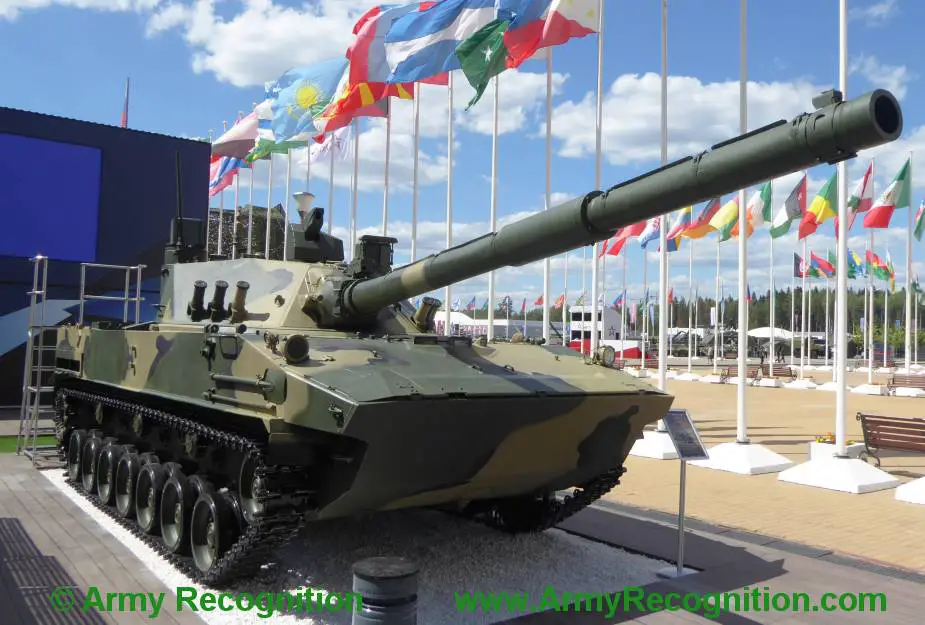Breaking news
Russian army to get Sprut-SDM1 SPATG self-propelled anti-tank gun.
The Russian Ministry of Defense has decided to procure the 2S25M Sprut-SDM1 self-propelled anti-tank gun (SPATG), according to the Izvestia daily. The number of the vehicles to be acquired by the Russian military is still unknown.
Follow Army Recognition on Google News at this link

Sprut-SDM1 (Picture source: Army Recognition)
The schedule of the Sprut-SDM1 deliveries to the units is now being hammered out, unspecified military sources told the newspaper. However, the principal decision to deliver the vehicle to the troops has already been made. According to the abovementioned sources, the 242nd Airborne Troops (VDV) Training Center will start training the commanders of the Sprut-SDM1 systems in 2021.
The baseline variant of the SPATG, the Sprut-SD, was officially adopted in 2006. The weapon was based on the BMD-4 airborne infantry fighting vehicle, and more than 10 SPATGs were delivered to the troops in the 2000s. However, in 2010, the MoD scrapped any further procurement of the Sprut-SD due to its low-quality design and poor armor protection.
In order to increase the combat survivability of the modernized gun, the industry has developed a more powerful ballistic protection suite for the Sprut-SDM1 SPATG. The weapon has been fully integrated with a digital fire-control system, which increases the platform’s firing accuracy and allows its crew to engage low-speed and low-altitude targets, for instance, helicopters and unmanned aerial vehicles (UAVs). The SPATG has received an Invar-M-based guided missile that is launched through the gun barrel. A variant of the missile with a thermobaric high-explosive warhead to engage field installations has also been developed.
“This floating and airdroppable vehicle has been armed with the basic 125 mm gun of main battle tanks and carries the full range of rounds. The system has been designed to support airborne troops of the battlefield. Previously, the VDV deployed only Nona-S 120 mm self-propelled mortars, which had a relatively low anti-tank capability. The new SPATG’s concept was arguable, resulting in multiple delays of its adoption. The upgraded variant of the system is fitted with a fully rebuilt fire-control system and a thermal imager, which bring the platform’s combat capacities close to that of main battle tanks. In fact, the Sprut-SDM1 is a light amphibious tank. There is a modern trend to develop such vehicles, and most platforms are almost equal to the upgraded Sprut in terms of firepower. However, no foreign country has light tanks that have amphibious and airdrop capabilities,” military expert Alexey Khlopotov told the Izvestia. According to him, the Sprut-SDM1 fully reveal its capabilities in environments with water barriers.
The Airborne Troops units armed with the new vehicle will be capable of fighting heavy armor, military expert Vladislav Yuriev told the Izvestia. “The troops always need such platforms. For instance, the BMD-2 airborne infantry fighting vehicle cannot engage a main battle tank. Previously, the Airborne Troops had only two anti-tank weapons, namely, rocket-propelled grenade launchers (RPGL) and anti-tank guided missile (ATGM) systems. An RPGL has an effective firing range of no more than 400 m, while an ATGM system has a low ammunition load that does not exceed three or four missiles. The tanks now become more maneuverable, and they will easily outflank and outmaneuver stationary batteries. Therefore, the troops need a powerful anti-tank gun with a sufficient ammunition load,” said Yuriev.
The Airborne Troops now form Russia’s rapid reaction force, said the Izvestia.
© Copyright 2020 TASS / Army Recognition Group SPRL. All rights reserved. This material may not be published, broadcast, rewritten or redistributed.


























